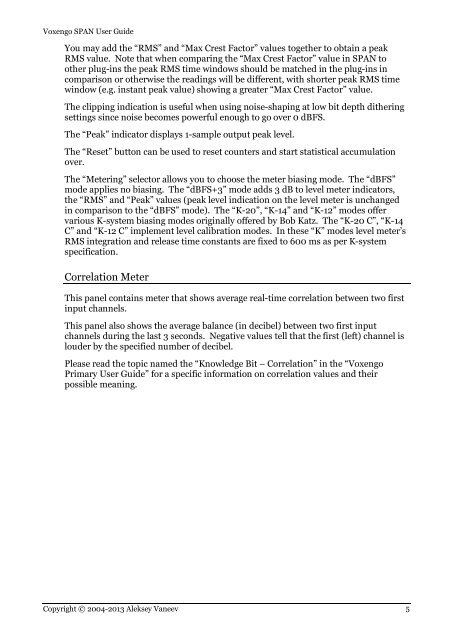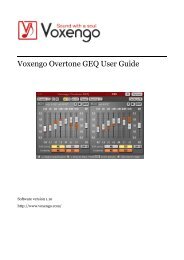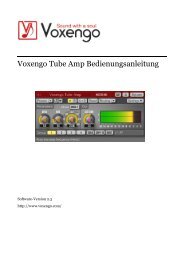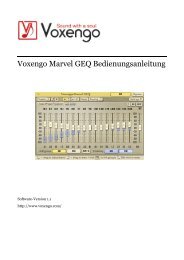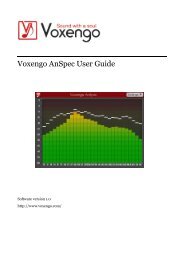Voxengo SPAN User Guide
Voxengo SPAN User Guide
Voxengo SPAN User Guide
Create successful ePaper yourself
Turn your PDF publications into a flip-book with our unique Google optimized e-Paper software.
<strong>Voxengo</strong> <strong>SPAN</strong> <strong>User</strong> <strong>Guide</strong><br />
You may add the “RMS” and “Max Crest Factor” values together to obtain a peak<br />
RMS value. Note that when comparing the “Max Crest Factor” value in <strong>SPAN</strong> to<br />
other plug-ins the peak RMS time windows should be matched in the plug-ins in<br />
comparison or otherwise the readings will be different, with shorter peak RMS time<br />
window (e.g. instant peak value) showing a greater “Max Crest Factor” value.<br />
The clipping indication is useful when using noise-shaping at low bit depth dithering<br />
settings since noise becomes powerful enough to go over 0 dBFS.<br />
The “Peak” indicator displays 1-sample output peak level.<br />
The “Reset” button can be used to reset counters and start statistical accumulation<br />
over.<br />
The “Metering” selector allows you to choose the meter biasing mode. The “dBFS”<br />
mode applies no biasing. The “dBFS+3” mode adds 3 dB to level meter indicators,<br />
the “RMS” and “Peak” values (peak level indication on the level meter is unchanged<br />
in comparison to the “dBFS” mode). The “K-20”, “K-14” and “K-12” modes offer<br />
various K-system biasing modes originally offered by Bob Katz. The “K-20 C”, “K-14<br />
C” and “K-12 C” implement level calibration modes. In these “K” modes level meter’s<br />
RMS integration and release time constants are fixed to 600 ms as per K-system<br />
specification.<br />
Correlation Meter<br />
This panel contains meter that shows average real-time correlation between two first<br />
input channels.<br />
This panel also shows the average balance (in decibel) between two first input<br />
channels during the last 3 seconds. Negative values tell that the first (left) channel is<br />
louder by the specified number of decibel.<br />
Please read the topic named the “Knowledge Bit – Correlation” in the “<strong>Voxengo</strong><br />
Primary <strong>User</strong> <strong>Guide</strong>” for a specific information on correlation values and their<br />
possible meaning.<br />
Copyright © 2004-2013 Aleksey Vaneev 5


